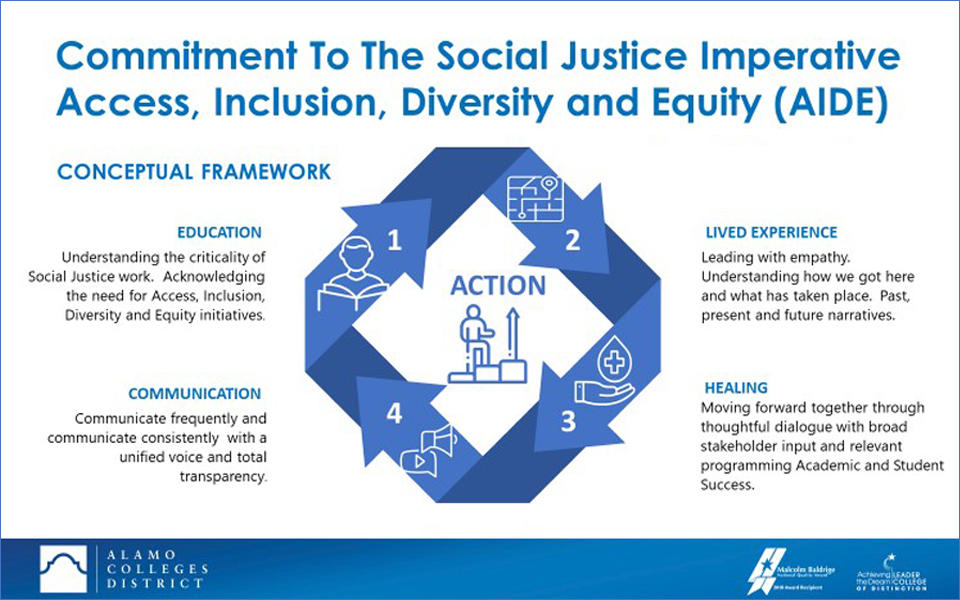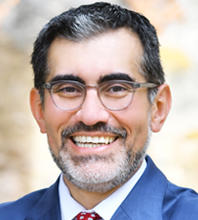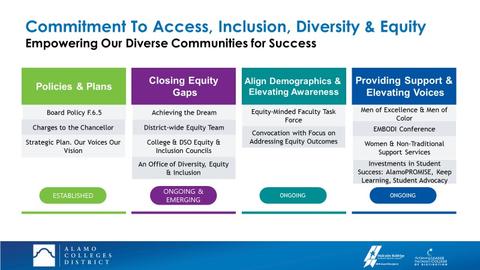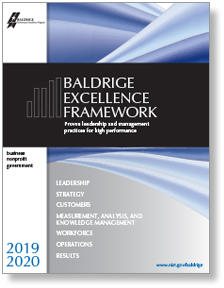Blogrige
The Official Baldrige Blog
Diversity, Equity, and Inclusion: Alamo Colleges District’s Use of the Baldrige Framework as a Social Justice Tool

As the largest provider of higher education in South Texas and with a 73% minority community, Baldrige Award recipient Alamo Colleges District is proud of its focus on diversity, access, and inclusion within an “Equity-Mindedness Ecosystem.” According to Chancellor Dr. Mike Flores, the district has a “moonshot to [partner to] end poverty in San Antonio through education.” This aligns with the district’s Students First culture: education is a pathway to promote a better life and fight poverty, hunger, and homelessness.

Alamo Colleges District
2018 Baldrige Award Recipient
San Antonio, TX, the location of the district’s five community colleges, has the nation’s highest urban poverty rate in the nation, a distinction shared with Miami. Of Alamo Colleges District’s students, 53% are economically disadvantaged, 62% are unprepared for college, and 70% receive financial aid.
Such data illustrate a district challenge of intergenerational poverty, where economic and social mobility are difficult. The data have led to a social justice imperative for the district, which seeks to propel its students out of poverty. Flores said the goal for students is “to have a better life as a result of a credential from one of our colleges.”
Focus on Voices: Students, Employees, the Community
To support diversity, equity, and inclusion, the district uses the Baldrige Excellence Framework as one of its tools because “it helps us focus on who we are, who we serve,” Flores said.
Our students . . . deserve the best educational experience. . . . [Ten years ago] . . . we had one of the lowest graduation rates both in Texas and in the nation. . . . Then we began the Baldrige journey. . . . Utilizing the Baldrige framework and different methodologies . . . has propelled us to be one of the best in the state, with some of the best graduation rates within the nation.
Dr. Mecca Salahuddin, director of strategic initiatives and performance excellence, said the district’s focus on social justice starts with increasing graduation rates. “The Baldrige framework really helped us to focus on . . . the ways in which we can serve our students better,” she said.
Partnering to End Poverty Through Education
Kristi Wyatt, associate vice-chancellor of communications and engagement, said that partnerships with other organizations emphasize listening. The partnerships have led to idea exchanges to understand the needs of students, the community, and our organization, said Wyatt. Partners include city transportation operators, health care providers, and other area colleges and universities.
The district has embedded policies and plans addressing diversity, access, inclusion, and equity; this includes board policy F.6.5 that commits to systemic transformation to make quality learning a shared priority. To understand learning needs, the Alamo Colleges District segments successful degree and certificate completion in the following equity categories: gender, ethnicity, economic status, veteran status, and disability status.
Wyatt said that in the district’s social justice work, identified needs are evolving. “Of course, in Baldrige we’re always looking for process improvement,” she added.
Closing Equity Gaps for Students

Closing equity gaps, which includes elevating awareness, is essential to help students achieve the dream of graduating and moving out of poverty, Wyatt said. A district-wide equity team; councils; an office of diversity, equity, and inclusion (in progress); and a faculty taskforce are looking at ways to embed diversity, equity, and inclusion within the curriculum.
As an example, the district just held an Empowering Males to Build Opportunities for Developing Independence (EMBODI) conference. The program is designed to collaborate with established organizations and agencies to address the issues of young men of color through dialogue, and to recommend change and action. As another example, the Annual Women in Non-Traditional Occupations (WINTO) conference is designed to encourage females to seek education in career technical education fields.
Investments in Student Success
AlamoPROMISE is the district’s major initiative to “move the needle … toward social and economic achievement,” said Flores. The program is intended to make college more accessible by providing support, including tuition and fees, to students who meet the eligibility criteria. Regional partner USAA recently invested $2 million in AlamoPROMISE.
“As we looked at equity in 2020 and what was needed for populations most significantly impacted by the pandemic, which in most cases were our minority students, we were able to invest in students . . . through access to free classes, support services, laptops, and hot spots,” said Flores. Advocacy centers at each of the district’s colleges also partnered to provide needed student services, such as free bus passes, pantry services, mental health care, and health care clinics.
Excellence in 2020
Flores said in spring 2020, as COVID 19 cases increased in San Antonio, district staff were concerned that students would not be able to complete their classes. The district extended spring break to prepare for virtual education. He said he is proud that “students [were still] able to cross the finish line”; the course completion rate at the end of the spring semester went from 91.1 percent to 91.8 percent.
Alamo Colleges District also found an increased role in helping to address the challenge that the pandemic adversely impacted communities of color and women (2/3 of the district’s student population are women heads of households). In addition, the district began seeing more 38-to-48-year-old students who had been displaced and sought new credentials
The district reallocated $10 million of its institutional money to support students to continue taking courses. It also waived or “scholarshipped” unpaid balances (up to three courses for summer of 2020). It ramped up a pop-up food market and food bank, and a telehealth partnership with the school of nursing. In addition, the district began partnering with the city and county on a job training program for unemployed adults. Alamo Colleges is the largest provider of that program, with a contract to train 5,000 individuals with new certifications.
“When you are already in a situation where you are trying to jump start [an education] … before you can even get to the finish line and you have a setback like COVID, I think it’s imperative to support our students, particularly our minority students, who are most affected,” said Wyatt. Added Salahuddin, “Many [students] were already on the margins before and then [2020] has compounded that. So our response is super critical.”
Social Justice in 2020
The challenges of 2020 have also brought an even clearer focus on social justice. The Alamo Colleges District’s human resources team has been reaching out to part- and full-time faculty (about 5,000 employees at the district) and student workers. For senior leaders, the team provides weekly reports on themes that have emerged during these conversations.
Salahuddin said, “Giving the employees the opportunity to share their feelings has helped them navigate [potential national and regional issues involving systemic racism]…. These have been really powerful [conversations].”
Recently, Dr. Flores partnered with a district trustee in bringing together faculty members and subject-matter experts from the regional higher education community, including from the University of Texas San Antonio and Texas A&M. In addition to conversations about equity, Flores said the educators have shared best practices and discussed how they could work collectively.
“COVID is itself a social justice issue,” said Salahuddin. “Alamo is a strong provider of student education … [to] the people that [the pandemic is] most impacting…. I think [students’ high satisfaction scores are] a great testament to the resiliency of our organization.”

Baldrige Excellence Framework
The Baldrige Excellence Framework has empowered organizations to accomplish their missions, improve results, and become more competitive. It includes the Criteria for Performance Excellence, core values and concepts, and guidelines for evaluating your processes and results.
Purchase your copy today!
Available versions: Business/Nonprofit, Education, and Health Care





